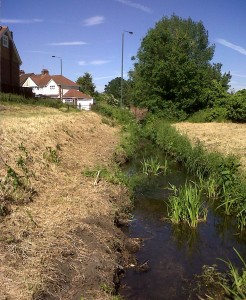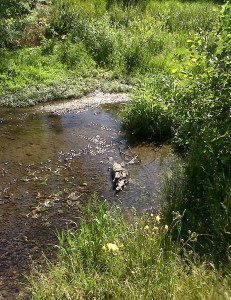Call it a bit mercenary, but I helped out on the BETHs stretch clean-up so I could cover a part of the river I’d not done before for the Water Vole survey I’m leading, without having to make special arrangements to get hold of waders. I decided I’d also yomp up to Parish Wood park’s large pond afterwards to try and put a few Odonata records on the board there.
Things started off well enough, if not somewhat frustratingly. There was a small-looking Hawker with distinctly green thorax sides and bluish abdomen spots – my first Dragonfly of the year – patrolling the grass/trees between BETHS footbridge and the A2 footbridge. Unfortunately I was already kitted out in waders and couldn’t chase it around, nor would it settle. The time of year and habitat is more suggestive of Hairy Dragonfly than Southern Hawker, though these insects will wander some distance. The behaviour was more Southern Hawker like, going some way up the sides of the large oak trees present, but the British Dragonfly Society latest sightings webpage still has no 2015 records of Southern hawker yet. This points to Hairy Dragonfly, which would be a significant range extension away from Thames Road Wetland where it was first seen in Bexley, by myself, and then Crossness where I also bagged the first record. I haven’t got much time to make another visit in the next few weeks, so if someone else can get a confirmation of the presence of this species along the Shuttle, let me know!
Along the river itself, wading revealed a small number of Large Red Damselflies settling on waterside vegetation in the sunlit sections, including a tandem mating pair, all not far from the Holiday Inn slip-road bridge. A male and female Banded Demoiselle were also here. Plants included the invasive Himalayan Balsam and Japanese Knotweed. The bank profile, concrete lining in at least some areas, extent of shading by trees and unsuitability of the vegetation ruled out Water Vole habitation, and no droppings were seen.
After the clean-up I hung around to see if I could get a better view of the dragonfly, but only got a couple more distant glimpses. At one point a bright blue bird drifted past and into an oak tree. It could only have been a Kingfisher, which was confirmed when it flew downstream to a branch overhanging the river. A Grey Wagtail was seen here earlier.
There were several Wrens along the Love Lane section, including a group of 3 that were probably recent fledglings, with a Song Thrush and Chiffchaff heard from the allotments side.
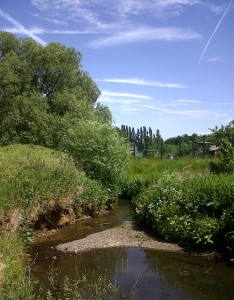
The Shuttle flowing past Love Lane allotment site. Exposed gravels as seen here provide foraging areas for Wagtails. (Photo: Chris Rose)
On the former allotments by Bexley park Woods was a Peacock butterfly.
There was a Grey Wagtail in the river on the Riverside Central section and another (or maybe the same bird) just upstream of Albany Road bridge later on. A less welcome sight was a traffic cone and a shopping trolley in the river here. Occasional Banded Demoiselles had been seen, but the heat was probably keeping Odonata from flying much. A plant of Russian Comfrey (Symphytum x uplandicum) was spotted flowering amongst long bankside grasses.
Worse was to come. The Penhill towards Sidcup Golf Course section of the river had been strimmed right down almost to the edge of the water. The Council has been written to for an explanation. It wouldn’t be the first outbreak of way-over-the-top strimming along the Shuttle. The only bright spot here was my first Small Copper butterfly of the season, from memory my first record of it in the Shuttle Corridor.
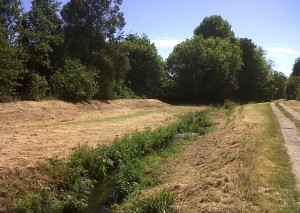
The Shuttle banks upstream of Penhill Road bridge had been strimmed right down to the waterside. The amount of debris left in the water suggested it wasn’t down to some crucial Environment Agency flood control action or the like. (Photo: Chris Rose)
I had a brief glimpse of another small Hawker type dragonfly in Marlborough Park. Instead of going after it I figured if it was Hairy Dragonfly it should come back. Unfortunately it didn’t, and I couldn’t relocate it further upstream.
As usual there were a number of House Sparrows around the river by the school in Willersley Park, despite the gratuitous destruction of some of the shrubbery they used to use.
A Holly Blue and Speckled Wood butterfly were seen by the woodland in Hollyoak Wood park.
Upon arrival at Parish Wood park I was greeted by the sight of some 52 Carrion Crows on the deck, presumably clearing up the remains of what had been thrown to the ducks. There were only three Mallard, but 2 adult Coot with 4 chicks. The side of the pond still in sun was seething with tadpoles. A young Fox came running enthusiastically out of the undergrowth before realising I was there and disappearing again.
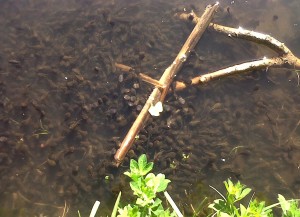
A seething mass of tadpoles in the large pond at Parish Wood Park, many with back legs developing. (Photo: Chris Rose)
This park is a good place to see a show of Greater Birdsfoot Trefoil (Lotus pedunculatus), larger, darker green and hairier than ‘straight’ Birdsfoot Trefoil, and with a hollow not solid main stem. This is a plant of damp rather than the drier places favoured by the latter species. There is a lot of it at Avery Hill, but in the Borough of Bexley I’ve so far only seen a single plant of GBT in Marlborough Park other than here. The related Meadow Vetchling was also present. Another plant of wet places found was Square-stalked St. John’s-wort. I can’t recall if I’ve seen it at Parish Wood before, but it has been recorded along the Shuttle by others in the past.
There was still virtually no Odonata action, though I’d hoped for perhaps 4 or 5 species. I had to make do with just two male Azure Damselflies. There was also a male Common Blue butterfly and a first for me here, a singleton of the attractive day-flying Burnet Companion Moth.
At Lamorbey lake a single Red Eyed Damselfly (Erythromma najas) was still holding territory on a Waterlily leaf at 18.30, and a teneral Blue-tailed damselfly was found.
6 male and 2 female Tufted Duck were on the lake. At least 2 (and possibly more) Coal Tits were in the Pines by the pathway leading towards the town centre, along with at least 1 Long-tailed Tit.
Finally, there was a Peregrine Falcon sat in an alcove high up on the side of Marlowe House. It looked like it was feeding on something.
Chris Rose

